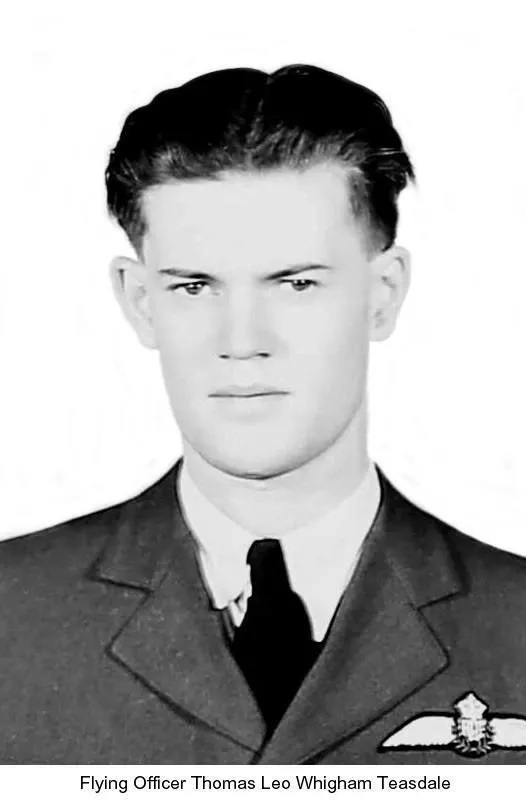Teasdale, Thomas Leo Whigham
Killed in Action 1944-03-25


Birth Date: 1922-October-28
Born: Drumheller, Alberta
Son of James Robert Whigham and Maude Ethel (nee Aram) Teasdale, of Vancouver, British Columbia. Brother of Flying Officer Harry Leo Teasdale, RCAF, killed in action 19 February 1945, James Frederick,
Home: Edmonton, Alberta
Enlistment: Calgary, Alberta
Enlistment Date: 1941-09-29
Service
RCAF
Unit
166 (B) Sqn- Squadron (RAF)
Tenacity
Base
RAF Kirmington
Rank
Flying Officer
Position
Flying Officer
Service Numbers
J/23404
Home
 Edmonton, Alberta
Edmonton, Alberta
Target
 Berlin Germany
Berlin Germany
First Burial
 Kempen
Kempen
Took off from Kirmington at 18:40 in Lancaster Mk III (Sqn code AS-T2 Bomber Command) on an operation to Berlin Germany.
Homebound crashed near Kempen Germany where those killed were buried 27 Mar 1944.
Killed includes Teasdale:Sergeant Walter Dawson RAF KIA Reichswald Forest War Cemetery grave 25. E. 4.Sergeant Leslie Gammage RAF KIA Reichswald Forest War Cemetery grave 25. E. 2.Sergeant Desmond Edward Hunt RAF KIA Reichswald Forest War Cemetery grave 25. E. 3.Warrant Officer Class 2 Fusi Eric Johnson RCAF R/128478 KIA Reichswald Forest War Cemetery grave 25. E. 1.WO John Skeel RAF KIA Reichswald Forest War Cemetery grave 25. E. 5.
POW:Flight Sergeant Jack Barton Auld RCAF J/24026 POW Stalag Luft L1 Barth Vogelsang.
Lancaster ED731
Avro Lancaster

Canadian Warplane Heritage Museum
The Avro Lancaster is a British Second World War heavy bomber. It was designed and manufactured by Avro as a contemporary of the Handley Page Halifax, both bombers having been developed to the same specification, as well as the Short Stirling, all three aircraft being four-engined heavy bombers adopted by the Royal Air Force (RAF) during the same wartime era.
The Lancaster has its origins in the twin-engine Avro Manchester which had been developed during the late 1930s in response to the Air Ministry Specification P.13/36 for a capable medium bomber for "world-wide use". Originally developed as an evolution of the Manchester (which had proved troublesome in service and was retired in 1942), the Lancaster was designed by Roy Chadwick and powered by four Rolls-Royce Merlins and in one version, Bristol Hercules engines. It first saw service with RAF Bomber Command in 1942 and as the strategic bombing offensive over Europe gathered momentum, it was the main aircraft for the night-time bombing campaigns that followed. As increasing numbers of the type were produced, it became the principal heavy bomber used by the RAF, the Royal Canadian Air Force (RCAF) and squadrons from other Commonwealth and European countries serving within the RAF, overshadowing the Halifax and Stirling. Wikipedia
166 (B) Sqn Tenacity (Huddersfield's Own)
No 166 Squadron RAF was originally formed at Bircham Newton, Norfolk on June 13, 1918, designed as a heavy bomber unit, to fly the Handley Page V/1500 aircraft. The squadron was never fully mobilized because the Armistice intervened. The squadron was re-formed in November 1936 as a heavy bomber unit, flying Handley Page Heyfords, later equipping with Armstrong Whitworth Whitleys. It was based at Boscombe Down, Wiltshire from November 1936 to January 1937, when it moved to Leconfield, Yorkshire. The squadron became part of an air observer's school on June 7, 1938, and then became a 1 Group pool squadron in May 1939. From September 1939 it was based at Abingdon, Berkshire until April 1940. In that month the squadron merged with no. 97 Squadron to form No. 10 OTU.
In January 1943 the squadron was re-formed at Kirmington, Yorkshire (53.578,-0.344, now Humberside Airport), from flights of Nos. 150 and 170 squadrons, when parts of these squadrons were posted to the Middle East. It was again bomber squadron, flying Vickers Wellingtons in No. 1 Group of Bomber Command. It remained at Kirmington until the end of WWII, later re-equipping with Avro Lancasters. In the period 27/28 January 1943 and 25 April 1945, it dropped 27,287 tons of bombs and laid 333 tons of mines. The squadron won "at least" 2 DSOs, 2 CGMs, 117 DFCs and 108 DFMs in the course of WWII. The squadron was disbanded on November 18, 1945.
 Canadian Virtual War Memorial
Canadian Virtual War Memorial
 Lancaster Bomber
Lancaster Bomber Wikipedia
Wikipedia Harold A Skaarup Web Page
Harold A Skaarup Web Page